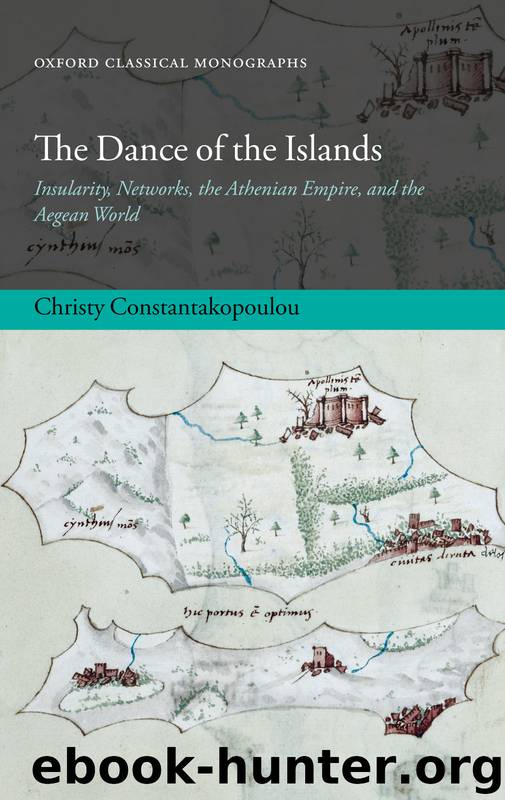The Dance of the Islands by Constantakopoulou Christy;

Author:Constantakopoulou, Christy;
Language: eng
Format: epub
Publisher: Oxford University Press, Incorporated
Published: 2010-03-18T16:00:00+00:00
7.3. SOME GENERAL REMARKS
The above examination of islands and their peraiai allows us to express some general remarks about the relationship between insular units and mainland territories. We need to stress, however, that there was no such thing as uniformity in the form of the peraia itself, as well as in the degree of dependence or control that the island imposed on its mainland territory.87 Still, the very existence of the term peraia in order to denote most of the above mainland territories, 88 does imply that the mainland territories controlled by an island were perceived as expressions of the same phenomenon. Absolute uniformity may have never existed in the history of the Aegean world, but at the same time, we can certainly observe some general trends that the islands and their peraia shared. For example, most of the peraiai were tied to the islands at an early time,89 and in the case of Thasos (and probably Samothrace) a very short period after the colonization of the island itself.90 Most peraiai, with the exception of Chios, covered quite wide areas of the mainland coast,91 which could later be reduced, as in the case of Mytilene, or enlarged, as in the case of Rhodes. The peraiai covered a mainly coastal territory with small inland penetration. This fact is obvious in the case of the Mytilenean peraia, where the term ‘shore of the Mytileneans (Mντιληναíων αιγιαλòς)’ is attested to denote this territory (Strabo 13.1.49 c605). The only exception to this rule of the coastal character of the peraia is the recent identification of Pistyros with Bulgarian Vetren, according to a newly discovered inscription.92 The location of the inscription now leaves no doubt of an existence of Thasian emporia in the heart of the Thracian inland territories.93 The new identification of Pistyros, however, cannot alter what seems to be the rule for all the other Aegean peraiai. Still one should perhaps note that the prevalence of coastal territories as parts of the peraiai did not obstruct the islanders from maintaining valuable links with the wealthy hinterlands of the mainland. In this respect, bonds with the locals were sometimes pursued, as the evidence of intermarriage with the locals from Thasos and her peraia attests.94 In any case, distance was an extremely important parameter in determining which territories would become island peraiai. 95 With the exception of Chios, which, as we saw, acquired her peraia as a gift in the sixth century, and therefore did not follow the ‘normal’ route of occupation and control, all other peraiai were in fact the coastal strip directly opposite the island itself.
Peraiai were undoubtedly extremely significant for island states. Peraiai provided the islands with valuable land for agriculture, timber, and even salt.96 For example, we have an inscription from the Samothracian peraia which mentions forts protecting the farmers of the area, the κληρονXήσονταs καí γεωργήσοντας τὴν Хὡραv (Syll3 502 = IG XII.8 156 b41–2).97 In the case of Thasos, the mines of the peraia must have been a considerable source of wealth for an already quite wealthy island.
Download
This site does not store any files on its server. We only index and link to content provided by other sites. Please contact the content providers to delete copyright contents if any and email us, we'll remove relevant links or contents immediately.
| Ancient & Classical | Arthurian Romance |
| Beat Generation | Feminist |
| Gothic & Romantic | LGBT |
| Medieval | Modern |
| Modernism | Postmodernism |
| Renaissance | Shakespeare |
| Surrealism | Victorian |
4 3 2 1: A Novel by Paul Auster(11784)
The handmaid's tale by Margaret Atwood(7445)
Giovanni's Room by James Baldwin(6803)
Asking the Right Questions: A Guide to Critical Thinking by M. Neil Browne & Stuart M. Keeley(5355)
Big Magic: Creative Living Beyond Fear by Elizabeth Gilbert(5348)
Ego Is the Enemy by Ryan Holiday(4950)
On Writing A Memoir of the Craft by Stephen King(4658)
The Body: A Guide for Occupants by Bill Bryson(4578)
Ken Follett - World without end by Ken Follett(4441)
Bluets by Maggie Nelson(4258)
Adulting by Kelly Williams Brown(4230)
Eat That Frog! by Brian Tracy(4147)
Guilty Pleasures by Laurell K Hamilton(4114)
White Noise - A Novel by Don DeLillo(3828)
The Poetry of Pablo Neruda by Pablo Neruda(3813)
Fingerprints of the Gods by Graham Hancock(3731)
Alive: The Story of the Andes Survivors by Piers Paul Read(3725)
The Book of Joy by Dalai Lama(3692)
The Bookshop by Penelope Fitzgerald(3615)
